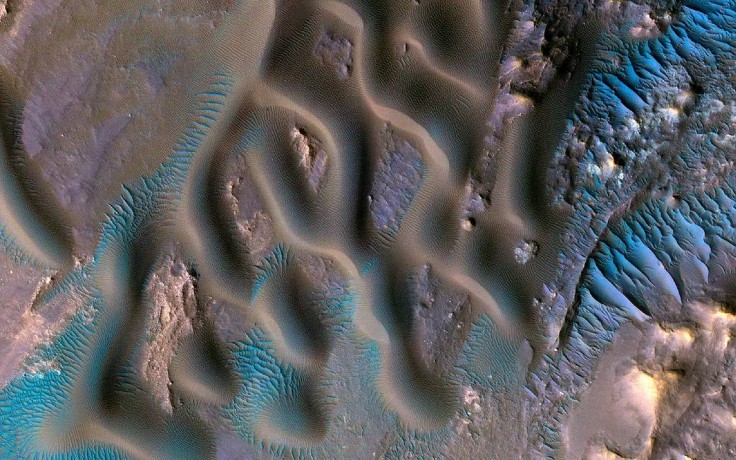On July 25, NASA released a photo of various wind-related formations on Mars near Gamboa Crater's center.

What Does the Image Shows
The space agency noted that individual domes and sinuous crests are formed by larger sand dunes. The Transverse Aeolian Ridges (TAR) are the larger, brighter formations that are almost parallel with each other. The sand which covers these TAR is quite coarse, as described by NASA.
The image also reveals that the dunes' tops have tiny ripples that span barely a few feet from crest to crest. These combine to form larger mega-ripples that extend from the sand dunes. These large ripples are about 30 feet apart.
On one side of an enhanced color cutout, the mega-ripples seem blue-green, and on the other, the TAR appears brighter blue. NASA said that this could be the result of the TAR actively moving against the wind's force, removing darker dust and enhancing their brightness.
What Is the Significance of This Image
The space agency said that false-color photos can teach us about the geology and weather on Mars. Scientists can discover information about the direction of the wind that formed those dunes in the distant past by studying photos like the one seen above.
The photos could aid scientists in deducing the characteristics of the component these formations are made of and explain how they formed.
How Does the Photo Captured
Space.com noted that the breathtaking photograph of a Martian dune field taken by NASA's Mars Reconnaissance Orbiter reveals intricate details that could aid researchers in understanding historical weather patterns on the Red Planet.
The probe, which was intended to look for signs of previous water on the now-arid Martian surface, demonstrated that the planet might have once supported life.
For more than 16 years, the Mars Reconnaissance Orbiter has been keeping an eye on Mars. The orbiter also assists mission teams in choosing landing sites for prospective missions and acts as a data relay for NASA's Martian rovers Curiosity and Perseverance.
Read More : NASA's Participation in the International Space Station Has Been Extended by Congress to 2030
NASA's Mars Mission
According to NASA, the Mars Exploration Program (MEP) aims to understand the following:
the possibility that there was life on Mars
how Mars differs and is similar to Earth
the geological and climate changes that have shaped Mars over time.
the upcoming human exploration of Mars
the planet's early development and formation
This would be made possible by MEP's exploration of Mars and provision of an ongoing stream of scientific knowledge and discovery through a carefully chosen series of robotic orbiters, landers, and mobile laboratories. These technologies are connected by a high-bandwidth Mars/Earth communications network.
Currently, MEP manages rovers and orbiters on and near Mars, participates in missions to Mars carried out by national and international partners, and develops and plans upcoming rover and orbiter missions.
NASA said that by acting as telecommunication relays for landed missions, MEP orbiters improve the scientific return of those missions and enable substantial improvement in data return.









